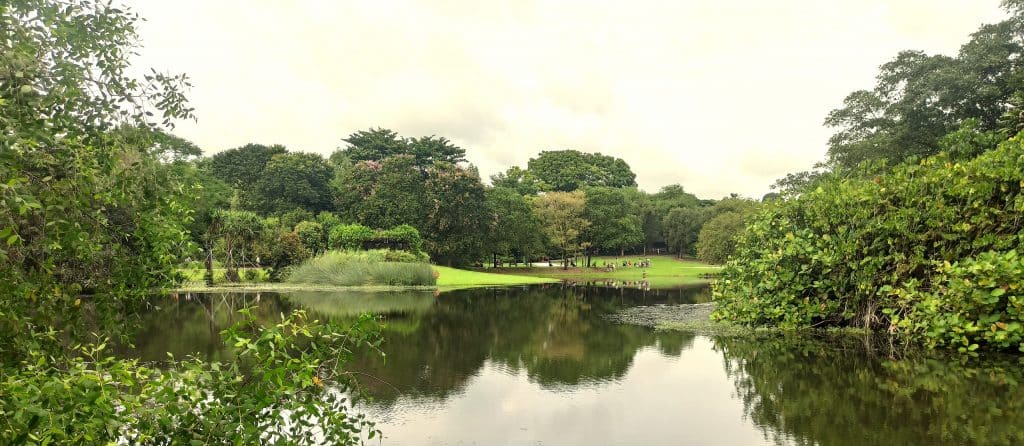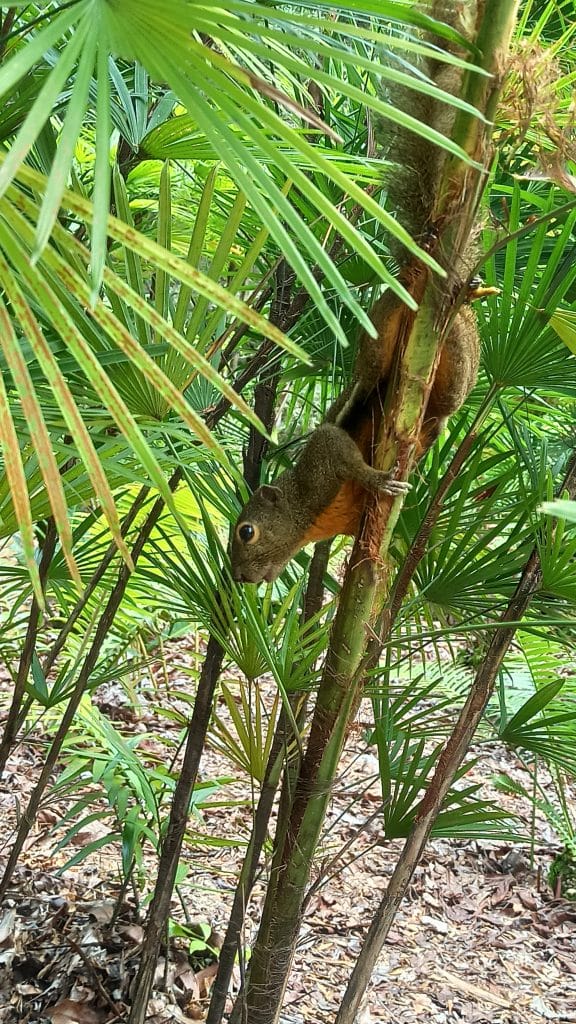Reflected in the pool is the landscape we have seen for almost a month. Infact, there is very little land in this scape, we are in a city. The towering blocks loom over this small patch of sunlight I’m enjoying while writing. But soon it will pass behind another tower, and there will only be concrete and glass to look at.
It’s not so bleak as all that. Our hotel does have some trees around it and the fire escape is turned into a feature with overflowing planters. But I think Aimi and I are both craving a bit more space and nature. We have come to Singapore, which is basically one huge fantastic city covering nearly the whole island, and spent 2 days going around gardens. We are tired of walking so much and looking forward to just enjoying staying still. But…
Today it was the National Botanic gardens just a few stops away on the metro. A 3km strip of greenery surrounded in city, it’s been preserved for 200 hundred years as a biological sanctuary and test bed for species of plants from all over Asia and the world.
The island was the site of a Malay fishing village inhabited by several hundred indigenous Orang Laut people. Sir Stamford Raffles, working for the British East India Company, established a port in 1819 at the southern tip of the Malay peninsula. This became a vital trading station, now Singapore. The Botanic gardens were a large part of the English vision for Singapore and the territories in Asian. Plants were brought here from all over the world to see how they would grow in the equatorial tropical environment. Many like rubber and pepper became hugely economical valuable. Ships would use this as a port on their trading routes between Europe, India and China. It grew and prospered as an industrial port nation, part of the British colonies for over 100 years until WWII.





Britain lost Singapore to Japan and in the wake of the war, facing high unemployment, inadequate housing and civil unrest, lost the trust of the Singapore people. In 1959 Singapore became self-governing and then declared independence from Britain unilaterally in August 1963 as part of the Federation of Malaysia. Two years later in 1965, Singapore left this to become an independent country. Still being located ideally in a trading route, the new government promoted foreign investment and joint venture companies from across the globe to set up in Singapore. As a result of Singapore’s steady political climate, favourable investment conditions and the rapid expansion of the world economy from 1965 to 1973, the country’s Gross Domestic Product (GDP) experienced annual double-digit growth leading it to outstrip most surrounding Asian countries productivity. Now, Singapore has successfully transitioned from industrial to financial and technological industries. Its now one of the global leading centers for finance. I had to educate myself about Singapore, because its interesting how such a small island nation has generated such wealth and developed to become so modern, compared to many others nations geographically proximate to it.
Singapore feels like what London should be. Clean, modern, well developed, with gardens and reliable public transport. Heck, its so hot and rains so hard here that lots of public walkways at the side of the road are covered with a roof. Surely it rains enough in the UK that this would be useful? More interestingly, something like this has hardly any economic benefit. Its only a social benefit, keeping people cool from the sun and dry from the rain. I struggle to think of similar examples in the UK…? Its frustrating to know how good it could be, or am I only seeing greener grass on the other side of the fence? Perhaps, but certainly the UK can learn a lot from Singapore and Japanese cities.
We walked around the whole place, enjoying the trees and plants, flowers and lakes. Particularly interesting were the Strangler Fig trees. These have a peculiar lifecycle were the seeds are mobalised by bats and drop into other trees crevices and nooks in branches. Here they germinate, grow and drop feeler roots to the forest floor. These wrap around the trunk and branches of the host tree, getting thicker as it grows and drops more roots. Soon the roots reach the ground and it starts pulling up nutrients and growing all over the host tree, suffocating it. By the time the host tree dies, the Suffocating Fig is well established and strong enough to stand on its own. It looks like hundreds of trees all growing and melding into one and splitting off in all directions, not just 1 plant. They must grow pretty quickly because they were also growing over rocks and fences around the park.
As we walked we kept our eyes peeled for Monitor Lizards. These monsters enjoyed basking in the sun and digging thru the leaf litter. We watched one searching and finding bugs to eat which was pretty cool.
There were also some petrified tree trunks. Trees that had fallen into a swamp and then been crushed and had their cells replaced by minerals till they became stone. It was very strange to see the fibrous surface of wood, but feel solid stone.







We both enjoyed the big green houses yesterday, (mostly for the air-con) but this park was better because it had animals all over it. Turtles swimming in the ponds, loads of little colourful fishes, striped squirrels, random chickens, birds, butterflies, lizards and geckos. But Aimi was disappointed not to see any snakes or otters, despite seeing signs warning of them. We didn’t s any, but we could hear bugs. It was like a really high alarm call beeping tone that got faster and faster till it just turned to static noise and then started over again. Very loud. But still not as loud as thr hoards of people in the greenhouses. It was much more peaceful, over all, walking around the botanic gardens.
By about 2pm, I was cooked. Its so hot out in the open. Even stopping in an air conditioned cafe for some spicy cheesy chips, and getting an Ice cream later on, it was draining feeling so sweaty for so long. On the way back to the hotel, we stopped in a shopping centre. Aimi decided that the best food on a hot day would be ramen… Hot Japanese noodle soup. It was tastey, but as soon as we did make it back to the hotel, I was in the pool.
